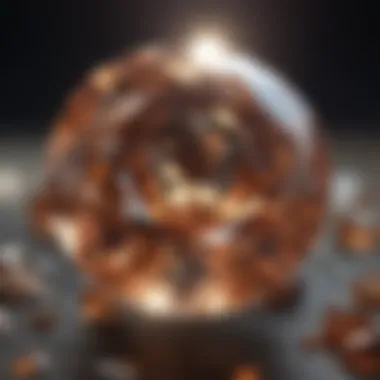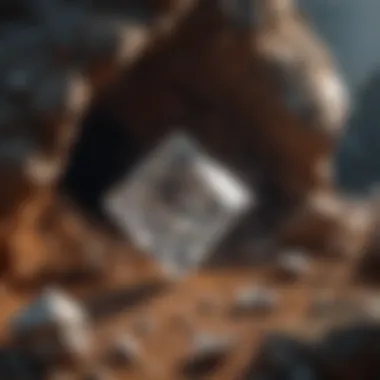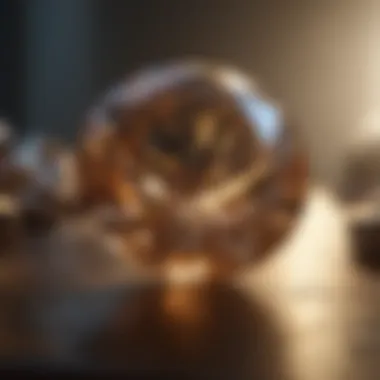Unveiling the Alluring Characteristics of Diamonds: A Fascinating Exploration


Delve into the fascinating world of diamonds as we explore the exceptional traits that make these precious gemstones truly remarkable. From their unique formation to their exquisite properties, diamonds hold a timeless allure that captivates enthusiasts and collectors alike. Join us on a journey of discovery through the multifaceted characteristics of diamonds, unravelling the secrets of these extraordinary treasures.
Rock and Fossil Identification
Diamonds, unlike traditional rocks and fossils, possess a brilliance and enduring quality that set them apart in the mineral world. The key characteristics to look for in diamonds include clarity, color, cut, and carat weight, all of which significantly influence the value and rarity of each gemstone. Appropriate tools for diamond identification encompass magnifiers, loupes, and specialized gemological instruments that aid in examining the intricate details of these exquisite jewels.
Collecting Tips and Techniques
While collecting diamonds is less about physically extracting specimens and more centered around procurement through jewelry or gemstone dealers, there are essential practices to adhere to. Best collecting practices involve verifying the authenticity and quality of diamonds through certifications provided by reputed gemological laboratories. Locating prime sources for diamond acquisition may include reputable jewelry stores, auctions, or online platforms known for their credibility in offering authentic gemstones. It is paramount to exercise caution and due diligence to ensure the legitimacy of the diamonds being acquired.
Preservation and Display
Preservation techniques for diamonds focus more on safeguarding their quality and brilliance rather than preventing decay or deterioration. Proper storage methods include keeping diamonds in soft pouches or containers to prevent scratching and minimize exposure to sunlight, which may affect their color intensity over time. Creative display ideas range from showcasing diamonds in elegant jewelry settings to incorporating them in various art forms or decorative displays that highlight their beauty and allure.
Geological Insights
Although diamonds originate from deep within the Earth's mantle through unique geological processes involving extreme pressure and temperature, their significance extends far beyond their geological formation. Historical significance is tied to diamonds being symbols of wealth, luxury, and endurance throughout various cultures and civilizations. Notable discoveries in the field of diamonds include groundbreaking advancements in diamond synthesis, exploration of diamond mines, and technological innovations in cutting and polishing techniques that continue to shape the diamond industry.
Introduction to Diamonds
Delving into the world of diamonds is a mesmerizing journey through the depths of Earth's mysteries and the brilliance of nature's craftsmanship. The foundation of our fascination with diamonds begins with their intriguing formation process and extends to the exquisite properties that make them truly unique. In this article, we aim to unravel the secrets behind these precious gemstones, shedding light on their origin, allure, and significance in the realm of luxury and beauty.
Formation of Diamonds
The Earth's Mantle
The Earth's Mantle, a vast layer residing beneath the planet's crust, plays a crucial role in the formation of diamonds. This reservoir of molten rock and minerals provides the ideal conditions for carbon atoms to crystallize under immense pressure and heat. The high temperatures and pressures within the mantle create the perfect environment for diamond formation, transforming carbon molecules into the dazzling gemstones we admire. The Earth's Mantle serves as a remarkable natural factory for diamonds, showcasing the wondrous power of geological forces.
Extreme Pressure and Temperature
Extreme pressure and temperature act as the alchemists behind the metamorphosis of carbon into diamonds. The immense forces exerted on carbon deep within the Earth's mantle compress and rearrange its atomic structure, shaping it into the coveted gemstone renowned for its hardness and brilliance. This miraculous transformation unfolds over thousands of years, culminating in the creation of diamonds that mesmerize with their beauty and durability. The synergy of pressure and temperature in diamond formation exemplifies nature's intrinsic ability to craft treasures of extraordinary value.
Kimberlite Volcanic Pipes
Kimberlite volcanic pipes serve as the pathways for diamonds to ascend from the depths of the Earth to its surface. These geological conduits transport diamonds from their underground origins to regions where they can be discovered and mined. The unique composition of kimberlite, rich in minerals and rocks from deep within the Earth, brings diamonds closer to human reach, unlocking the Earth's hidden treasures for exploration and admiration. Kimberlite volcanic pipes represent the adventurous journey of diamonds, from their clandestine formation to their dazzling emergence in the world above ground.
Physical Properties of Diamonds
The physical properties of diamonds play a pivotal role in understanding the allure and value of these exquisite gemstones. In this article, we delve into the specific elements, benefits, and considerations that make the physical properties of diamonds a fascinating topic of exploration. From the brilliance and fire they exhibit to their color variations and clarity, each aspect contributes to the overall beauty and mystique of diamonds.
Brilliance and Fire
Dispersion of Light
The dispersion of light in diamonds is a mesmerizing phenomenon that adds to their unparalleled brilliance and fire. This specific aspect of light dispersion contributes significantly to the overall radiance and scintillation of diamonds, making them truly dazzling. The key characteristic of light dispersion lies in the way diamonds break down white light into its spectral colors, creating a stunning play of hues. This unique feature enhances the beauty of diamonds, making them a popular choice for connoisseurs and collectors alike. Despite its advantages in enhancing the visual appeal of diamonds, excessive dispersion can sometimes lead to a rainbow effect, which may be considered a disadvantage in certain settings.
Scintillation
Scintillation, also known as sparkle, refers to the flashes of light that occur when a diamond moves. This particular aspect of a diamond's beauty contributes greatly to its overall allure and charm. The key characteristic of scintillation lies in the pattern and intensity of the light reflections within the diamond, creating a mesmerizing visual experience. The unique feature of scintillation is its ability to capture and reflect light from various angles, adding depth and dynamism to the gemstone. While scintillation enhances the diamond's beauty and appeal, excessive or uneven scintillation may sometimes detract from its overall elegance.
Refraction and Reflection


Refraction and reflection are essential processes that contribute to the diamond's brilliance and fire. The interplay of refraction, where light bends as it enters and exits the diamond, and reflection, where light bounces off the internal surfaces, creates the mesmerizing optical effects that diamonds are known for. The key characteristic of refraction and reflection lies in their ability to maximize the diamond's luminosity and shine. This unique feature ensures that light is effectively trapped within the diamond, resulting in a stunning display of brightness and radiance. While refraction and reflection enhance the diamond's beauty, inappropriate cuts or facets can sometimes lead to light leakage, diminishing the gem's overall sparkle and allure.
Symbolism and Cultural Significance
In the vast realm of diamonds, their symbolism and cultural significance hold profound importance, resonating through history and civilizations. Understanding the symbolic layers adds a depth to the enchantment of these gemstones that goes beyond their material worth. As conduits of cultural expression, diamonds have symbolized various aspects of human life and society, shaping traditions and narratives around the world.
Historical Perspectives
Royal Connections
Royal connections trace back to ancient times when diamonds adorned the crowns and jewelry of monarchs, signifying power, sovereignty, and divine right. The allure of diamonds in royal settings reflects opulence and magnificence, preserving legacies for generations. Their association with royalty elevates their prestige and adds a regal touch to any piece.
Religious Symbolism
Religious symbolism imbues diamonds with spiritual significance, symbolizing purity, eternity, and divine grace. Across different faiths and beliefs, diamonds carry sacred meanings, amplifying their allure beyond mere aesthetics. They serve as sacred talismans, connecting the earthly with the divine in profound ways.
Artistic Inspirations
Artistic inspirations draw from the brilliance and beauty of diamonds, inspiring creations that transcend the ordinary. Artists have long been captivated by the sparkle and allure of diamonds, translating their brilliance into masterpieces that evoke emotions and admiration. The artistry behind diamond-inspired creations unveils the infinite possibilities of this precious gem.
Modern Symbolism
Love and Romance
In modern times, diamonds symbolize love and romance, embodying enduring commitment and affection. As iconic symbols of everlasting love, diamond engagement rings and gifts express deep emotions and create lasting memories. Their brilliance mirrors the eternal bond shared between individuals, making them timeless tokens of affection.
Wealth and Status
The association of diamonds with wealth and status dates back centuries, signifying prosperity and social standing. Owning diamonds has been a hallmark of affluence and influence, showcasing one's success and discernment. Their portrayal as symbols of luxury and achievement continues to shape their allure in contemporary society.
Endurance and Strength
Diamonds symbolize resilience and strength, reflecting their exceptional hardness and durability. Just as diamonds endure extreme pressure to form, they epitomize fortitude and perseverance in the face of challenges. Their symbolic representation as symbols of strength resonates with individuals seeking courage and resilience in their endeavors.
Mining and Ethical Concerns
In the complex world of diamond mining, the significance of ethical considerations cannot be overstated, especially in our modern context where sustainability and ethical practices take center stage. This section dives into the crucial intersection of mining practices and ethical concerns, shedding light on the impact of diamond mining on the environment and local communities. By focusing on key elements such as ethical mining practices, social responsibility, and sustainable approaches, this article aims to provide a comprehensive overview of the ethical considerations within the diamond industry.
Environmental Impact
Ecological Footprint
Exploring the ecological footprint of diamond mining reveals the lasting impact of this industry on natural ecosystems. The extraction process, transportation, and refining stages contribute to a significant environmental footprint. Highlighting the carbon emissions, deforestation, and habitat destruction associated with diamond mining underscores the need for sustainable practices. Understanding the ecological footprint of diamonds is essential for making informed decisions regarding their consumption and supporting eco-friendly initiatives within the industry.
Land Disruption
Land disruption is a key aspect of diamond mining that often goes unnoticed. The excavation of mines leads to irreversible changes in landscapes, affecting biodiversity and local communities. By delving into the disruptive nature of mining activities, this article addresses the trade-offs between economic gains and environmental conservation. Examining the implications of land disruption prompts a critical reflection on the long-term consequences of diamond extraction and the importance of responsible land management practices.
Water Usage
The utilization of water in diamond mining processes poses a significant challenge to sustainability efforts. Water-intensive methods such as washing and processing ore contribute to water scarcity and pollution in mining regions. Analyzing the water usage patterns within the diamond industry sheds light on the need for efficient water management strategies. Discussing the impact of diamond mining on water resources underscores the urgency of adopting water-saving technologies and implementing responsible water stewardship practices throughout the mining lifecycle.


Ethical Sourcing
Conflict-Free Diamonds
The concept of conflict-free diamonds addresses the ethical concerns related to diamond extraction in regions plagued by civil unrest and human rights violations. By supporting conflict-free diamonds, consumers contribute to peace-building efforts and promote ethical supply chains. Exploring the significance of conflict-free certification schemes emphasizes the role of consumers in fostering transparency and accountability within the diamond industry. Choosing conflict-free diamonds aligns with ethical values and reinforces the demand for responsible sourcing practices.\n
Fair Trade Practices
Fair trade practices in the diamond industry aim to ensure equitable treatment of miners and artisans involved in the production process. By incorporating fair trade principles, diamond companies prioritize fair wages, safe working conditions, and community development initiatives. Discussing the impact of fair trade practices on the livelihoods of small-scale miners and vulnerable communities highlights the social responsibility aspect of ethical diamond sourcing. Supporting fair trade initiatives empowers marginalized groups and fosters sustainable growth within the diamond supply chain.
Sustainable Mining Initiatives
Embracing sustainable mining initiatives represents a commitment to minimizing the environmental and social impacts of diamond extraction. By promoting responsible mining practices, companies strive to reduce their carbon footprint, conserve natural resources, and support local communities. Exploring innovative approaches to sustainable mining, such as reclamation projects and renewable energy integration, showcases the industry's progress towards greater sustainability. Investing in sustainable mining initiatives signals a shift towards a more ethical and environmentally conscious diamond sector.
Diamond Cuts and Settings
In the realm of diamonds, the choice of cut and setting plays a pivotal role in enhancing their beauty and allure. Diamond cuts determine the way light interacts with the gemstone, showcasing its brilliance and fire. Settings, on the other hand, securely hold the diamond in place while also adding aesthetic appeal. Understanding diamond cuts and settings is crucial for those who appreciate the finer details of these exquisite gems. It allows for personal expression and customization, making each piece truly unique and special.
Popular Diamond Cuts
Round Brilliant
The Round Brilliant cut is a timeless classic renowned for its unparalleled sparkle and beauty. Its symmetrical shape and precise faceting maximize the diamond's ability to reflect light, creating a stunning display of brilliance. This cut is favored for its versatility and timelessness, making it a popular choice for various jewelry styles. While it may lack the uniqueness of other cuts, its widespread appeal and universal beauty make it a sought-after option for those seeking a traditional yet captivating look.
Princess Cut
The Princess Cut stands out for its modern and geometric appearance. With its sharp corners and pyramid-like shape, this cut exudes a contemporary elegance that appeals to individuals looking for a distinctive and eye-catching design. The Princess Cut combines the brilliance of a Round Brilliant with the sleek angles of a square cut, offering a blend of classic glamour and contemporary flair. Its versatility makes it a popular choice for engagement rings and other statement pieces.
Emerald Cut
The Emerald Cut is prized for its vintage charm and sophisticated allure. Featuring stepped facets that create a hall-of-mirrors effect, this cut highlights the diamond's clarity and luster. The elongated shape of the Emerald Cut lends an elegant and elongating look to the gemstone, making it a favorite among those who appreciate refined and understated glamour. While it may not sparkle as brightly as other cuts, its unique beauty and historic appeal make it a timeless and sophisticated choice for connoisseurs.
Setting Styles
Solitaire
The Solitaire setting is a classic and timeless choice that puts the spotlight on the center diamond. With a single diamond held in place by prongs, the Solitaire setting showcases the beauty and brilliance of the gemstone without distractions. This setting allows the diamond to stand out as the focal point of the jewelry piece, symbolizing purity and eternal love. Its simplicity and elegance make it a versatile option suitable for a variety of diamond shapes and sizes.
Halo
The Halo setting surrounds the center diamond with a halo of smaller diamonds or gemstones, accentuating its sparkle and size. This setting adds a glamorous and larger-than-life effect to the main diamond, creating a dazzling display of brilliance. The Halo setting enhances the overall aesthetics of the piece while providing additional sparkle and dimension. It is a popular choice for individuals who desire a luxurious and ornate look with a touch of vintage-inspired charm.
Pavé
The Pavé setting features small diamonds or gemstones set closely together on the surface of the jewelry piece, creating a sparkling and shimmering effect. This setting style adds texture and brilliance to the overall design, enhancing the beauty of the center diamond. With the surrounding stones appearing like a paved pathway, the Pavé setting exudes glamour and sophistication. It is favored by those who appreciate intricate detailing and a touch of extravagance in their jewelry.
Investing in Diamonds
Investing in diamonds is a topic of significant importance within this comprehensive guide on the intriguing traits of diamonds. Diamonds hold not just aesthetic value but also serve as a store of wealth and investment option. The allure of diamonds as an investment lies in their lasting value and the ability to diversify one's portfolio with a tangible asset. Investors often turn to diamonds for their stability and the prestige associated with owning rare and valuable gemstones. Understanding the key aspects of investing in diamonds such as market trends, pricing factors, and investment strategies is crucial for those considering this alternative asset class.
Market Trends


Price Fluctuations
Price fluctuations in the diamond market play a crucial role in shaping the investment landscape. The inherent rarity of diamonds coupled with fluctuations in demand and supply directly impacts their pricing dynamics. Investors closely monitor price trends to capitalize on opportunities for buying and selling. Knowing how price fluctuations influence diamond values is essential for making informed investment decisions. While price fluctuations can offer opportunities for profit, they also pose risks due to market volatility.
Demand and Supply
The interplay between demand and supply is a key factor influencing diamond prices. Shifts in global demand, affected by various factors including economic conditions and consumer preferences, can lead to fluctuations in diamond prices. Understanding the delicate balance between demand and supply allows investors to anticipate price movements and adjust their investment strategies accordingly. By staying abreast of demand and supply trends, investors can make informed decisions to optimize their diamond portfolios.
Investment Strategies
Developing sound investment strategies is paramount when venturing into the diamond market. Strategies may vary depending on investment goals, risk tolerance, and time horizon. From strategic buying during market downturns to the long-term holding of rare diamonds, each strategy comes with its unique advantages and considerations. Diversification, thorough market research, and a long-term perspective are some of the key elements to successful diamond investment strategies.
Certification and Appraisal
Gemological Institutes
Gemological institutes play a crucial role in the diamond industry by providing unbiased assessments of diamond quality and authenticity. Professional certifications from reputable institutes instill confidence in investors regarding the quality and value of their diamond purchases. The Gemological Institute of America (GIA) and other accredited institutes set industry standards for diamond grading, ensuring transparency and trust within the market.
Valuation Methods
Accurate valuation of diamonds is essential for investors looking to assess their portfolio's worth. Various valuation methods exist, including the 4Cs (cut, color, clarity, carat weight) and market comparisons. Each method offers insights into different aspects of diamond value, helping investors make informed decisions on buying, selling, or holding diamonds. Understanding the nuances of valuation methods is vital for gauging the potential return on diamond investments.
Insurance Considerations
Insuring diamond investments safeguards against potential financial losses due to theft, damage, or loss. Evaluating insurance options tailored to the specific needs of diamond investors ensures comprehensive coverage and peace of mind. Factors such as security measures, appraisal documentation, and coverage limits need to be carefully considered when selecting insurance policies for diamond assets. Proper insurance considerations provide a layer of protection for investors in the unpredictable world of diamond investments.
Unveiling the Beauty of Diamonds
Exploring the personalized appeal of diamonds brings a profound insight into their allure and significance within the realm of precious gemstones. Encompassing custom design, sentimental value, and legacy pieces, this facet of diamonds adds a unique dimension to their beauty and desirability. Each element contributes to the overall allure of diamonds, highlighting the personalization and emotional connections they hold for individuals.
Personalized Appeal
Custom Design
Delving into the realm of custom-designed diamonds reveals a realm where individuality and creativity converge. Custom design allows for the creation of unique, one-of-a-kind pieces that reflect personal style and preferences. The key characteristic of custom design lies in its ability to translate personal visions into tangible, breathtaking creations. The allure of custom design lies in the exclusivity and personal touch it adds to diamond jewelry, making it a popular choice for those seeking to make a symbolic statement. While custom design offers unparalleled uniqueness, it may involve higher costs and longer production timelines compared to ready-made pieces, emphasizing the importance of careful consideration in this article.
Sentimental Value
The sentimental value associated with diamonds transcends mere monetary worth, delving into emotional attachments and cherished memories. Diamonds often carry sentimental value passed down through generations, symbolizing love, commitment, and enduring connections. The key characteristic of sentimental value lies in its ability to evoke profound emotions and serve as tangible reminders of significant life events. Recognized for its emotional depth, sentimental value adds a distinct layer of meaning to diamond jewelry, making it a poignant choice for gifting and commemoration within the context of this article.
Legacy Pieces
Exploring the realm of legacy pieces uncovers a realm where diamonds become timeless heirlooms, carrying stories and legacies across lifetimes. Legacy pieces encompass jewelry that holds historical significance or personal narratives, becoming treasured family possessions. The key characteristic of legacy pieces lies in their ability to bridge past, present, and future, serving as symbols of heritage and continuity. Legacy pieces offer a connection to one's roots and ancestry, making them sought-after choices for those who value tradition and history in the context of this article.
Future of Diamond Industry
Innovations in Cutting
The future of the diamond industry is shaped by continual advancements in cutting techniques, enhancing the brilliance and precision of diamond craftsmanship. Innovations in cutting introduce new methods and technologies that optimize the light performance and beauty of diamonds. The key characteristic of innovations in cutting is their ability to push the boundaries of traditional diamond cutting, creating mesmerizing patterns and shapes that captivate the eye. These innovations offer benefits such as increased sparkle and scintillation, making them popular choices for those seeking the latest in diamond aesthetics within the scope of this article.
Sustainable Practices
The evolution of the diamond industry towards sustainability underscores the importance of ethical sourcing and environmental stewardship. Sustainable practices encompass initiatives that minimize the ecological footprint of diamond mining and promote responsibly sourced materials. The key characteristic of sustainable practices lies in their commitment to environmental conservation and community welfare, making them a preferred choice for eco-conscious consumers. By prioritizing ethical sourcing and transparent supply chains, sustainable practices offer advantages such as reducing environmental harm and supporting local communities within the narrative of this article.
Technological Advancements
Technological advancements are revolutionizing the diamond industry, introducing cutting-edge tools and processes that redefine the standards of diamond production. Through the integration of artificial intelligence, 3D modeling, and precision machinery, these advancements enhance the efficiency and accuracy of diamond manufacturing. The key characteristic of technological advancements is their role in streamlining operations, improving quality control, and enabling innovative designs. From diamond grading to laser cutting, technological advancements offer benefits like enhanced productivity and precision, making them pivotal in shaping the future landscape of the diamond industry as highlighted in this article.







